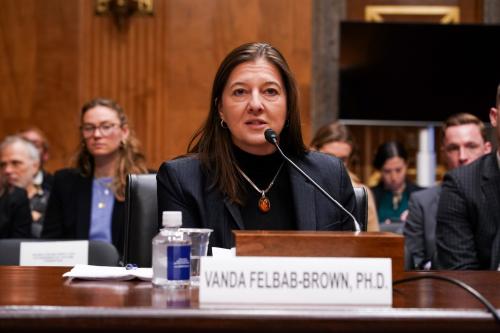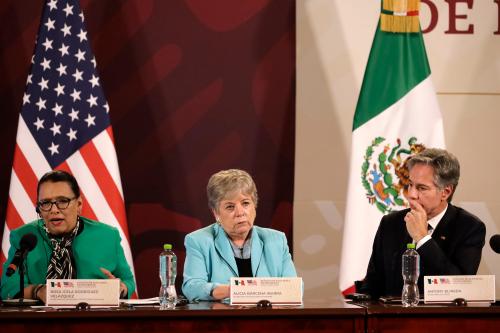The report of the Latin American Commission on Drugs and Democracy, an effort chaired by former Presidents Fernando Henrique Cardoso of Brazil, Ernesto Zedillo of Mexico, and César Gaviria of Colombia, launched in Rio de Janeiro last February and presented in Washington, D.C., at the Brookings Institution a few days ago, is undoubtedly a most significant addition to an urgent conversation in the Hemisphere. The document reads as a stern call to profoundly rethink the tenets of the status quo of counternarcotics policies in the U.S. It is a timely endeavor. With a new administration in the U.S., far less hooked to the socially conservative attitudes that have long defined the debate, it is conceivable that a frank discussion on drugs, both domestic and international, can at last begin.
Somewhat paradoxically, the current policy approach, heavily geared towards the eradication of illicit crops and the interdiction of drug supplies outside the U.S., as well as the punishment of consumers within the country, has become politically entrenched despite the all too glaring doubts about its efficacy. After one generation of zealous efforts by the U.S. administration, the casualties of the so-called “War on Drugs” continue to mount at a much faster pace than its achievements.
The report minces no words to point this out, offering solid evidence to sustain its claims. The Commission then calls for the adoption of a new paradigm to deal with narcotics, based on three principles: 1) Treating drug users as a matter of public health; 2) Placing much greater emphasis on the reduction of drug consumption through information, education and prevention; and 3) Focusing repression unrelentingly on organized crime. Stemming from these guidelines, a series of more concrete recommendations are offered, notably the need to evaluate according to the most advanced medical science the possibility of decriminalizing the possession of cannabis for personal use, as many countries in Western Europe have already done. While hardly a novelty –it was indeed proposed by the 1972 National Commission on Marijuana and Drug Abuse, convened and then rebuked by President Nixon—, the latter suggestion has already raised eyebrows in the U.S.
Three issues. Above and beyond the details of its contents, the report of the Latin American Commission for Drugs and Democracy raises at least three issues that deserve close attention:
The first one is about the notion of failure when it comes to counternarcotics efforts and, related to that, the kinds of costs that the “War on Drugs” entails for the Hemisphere. Is this war of sorts a failure, as the report categorically states?
The answer to this question depends, of course, on the measure of success that is used. If the metric is the containment of drug consumption in the U.S., it is possible to identify some legitimate achievements in the recent past. The proportion of the population consuming illicit drugs in the U.S. has remained largely stable for 20 years. Similarly, if the measure is the effectiveness of interdiction efforts, it is undeniable that drug seizures, particularly of cocaine, have skyrocketed in the past decade or so. If the phenomenon of interest is the area of coca leaf cultivation in Latin America, it is somewhat lower than it was 10 or 15 years ago.
Yet, if the metric of advancement is not just the containment but the reduction in the appetite for drugs in the U.S. and even more so in the Hemisphere as a whole, then it soon becomes clear that the status quo has achieved next to nothing. And the same applies if the focus is placed on the price of drugs on the street or at the actual production of cocaine in the Hemisphere, which is nearly as bad as it has ever been.
Focusing the discussion on the results of current counternarcotics efforts allows, hence, for a legitimate and interesting discussion. It is also a hollow one. For the real problem emerges when the direct and indirect costs of the prevailing policy framework are included in the equation. Then one cannot but conclude that the status quo is indeed an abject failure.
As the report lays bare the costs inflicted by the current policy framework are staggering throughout the Hemisphere. They start with the ten-fold increase in the number of people incarcerated for direct drug offences in the U.S. in the past 30 years, much of it for minor possession charges, a policy that eats up two-thirds of the budget allocated to counternarcotics efforts by the U.S. government, currently estimated at $21 billion annually. The costs get arguably worse beyond the U.S. borders, where the current approach, that has made inevitable the emergence of a gigantic black market in drugs controlled by organized crime, has generated enormous opportunities for corruption and incentives for violence.
The latter point deserves particular attention. Latin America, and in particular the Caribbean Basin (Central America, the Caribbean proper, and northern South America), has by some margin the world’s highest murder rates. While there are many significant factors associated to these figures, there is no doubt that drug trafficking is one of the main drivers of this tragedy.
One example should suffice to illustrate the point. The murder figures of Mexico in 2008 tell a very disturbing story, which is not the one that most people assume when watching the gory images and chronicles dished out by the media lately. The relevant story is not that the homicide rate is spiraling out of control. In fact, for Mexico as a whole it is not; it barely notched upwards in 2008, from 11 to 12 murders per 100.000 inhabitants. The really unsettling piece of information is that nearly one half of the murders in Mexico are directly related to drug trafficking, according to figures released by Mexico’s Attorney General.
The fact that the Mexican authorities have done this horrific headcount –which no other country has done—allows for an interesting “back-of-the-envelope” calculation. According to figures from the World’s Health Organization, about 140,000 people die in Latin America and the Caribbean (LAC) as a result of crime every year. It is plausible to assume, conservatively and for the sake of the argument, that a fourth of those deaths are related to drug trafficking. Other than in Mexico there is no way of knowing this for sure, but anecdotal evidence suggests that this is very likely the case, for example, in the author’s country – Costa Rica. If true, this would mean that probably 35,000 people, overwhelmingly young men, at the peak of their productive and reproductive lives, may be dying in LAC yearly as a result of the black market in drugs that the current policies render into existence.
What kind of war is that? At the very least, this cursory exercise should give us pause and force the question of whether preserving the current approach to narcotics is worth that much.
Violence is hardly the only cost foisted upon LAC by the “War on Drugs.” Two other hazards ought to be mentioned at this point, if nothing else because they are overlooked by the report. One is the danger of the militarization of law enforcement. It stands to reason that in particularly grave cases, such as Colombia or Mexico today, where the state’s monopoly of force is at stake, it may be necessary to call the military to deal with a problem that far exceeds what normal law enforcement institutions can cope with. Yet, the political history of Latin America being what it is, we must beware of the dangers of this option for democracy. Military intervention in the fight against drugs must be seen as an exceptional situation, which does not exempt the Armed Forces from basic rules of subordination to civilian authorities or change the civilian nature of the challenge.
The other cost is more difficult to pin down, but just as real. It concerns the erosion of the work ethic of an entire generation of young people in LAC. This can be easily understood by way of a simplified example, yet one seen time and again by the author in his own country. A reasonably ambitious young man living in any coastal town in Costa Rica –and we can be sure that this story plays itself out in thousands of communities all over the region—can certainly enroll and train to be a waiter in one of the nearby hotels. But just as easily, he can become a drug dealer. And for many people the choice is obvious. There is a generation in LAC growing up with the idea that there is plenty of easy money to be made. This can have devastating consequences in the long run for the region.
The second issue that calls for attention is the other “D” that is a part of this discussion as much as drugs and democracy, and which the report mentions just in passing: development.
In the Hemisphere, drug cultivation and drug trafficking are development issues. The trade in narcotics preys on very basic institutional weaknesses, on the feebleness and corruptibility of law enforcement mechanisms and, ultimately, on the inability of the state in many Latin American countries to have an effective presence in their territory. Drug trafficking takes full advantage of these weaknesses and makes them worse, generating parallel powers that contest the state’s monopoly of force. This is precisely the drama that is being played out in Mexico these days.
This, of course, raises a number of very thorny issues in Latin America. Here is an obvious one. How can anyone expect the Guatemalan State, for instance, to have an effective presence in the territory when tax revenues in Guatemala are barely 12% of GDP? Or 16% in Peru? Or 11% in Mexico?
The narcotics trade is also a development issue because the whole industry benefits from the existence of a huge reserve army comprised of young men with very limited opportunities. One fourth of the Latin American youth are out of school and out of work. That is a security time bomb. That is a lot of young lads willing to run any risk to make a living.
The point here is that if it is true that the tragedy that we are witnessing in the Hemisphere certainly calls for a profound revision of counternarcotics strategies and for some serious introspection in the U.S., it also requires that Latin American countries face up to some of their worst demons. These demons go beyond the ostensible failings of their law enforcement institutions, failings which in many ways are mere symptoms of basic and pending development challenges. So, yes, this is indeed a shared problem for the Hemisphere, in more ways than one.
The third issue, arguably the most decisive one, is about the nature of the discussion. The report puts it sharply: “Effective policies must be based on scientific knowledge and not on ideological biases.” Well said.
One of the real tragedies of the debate on narcotics is that it has become in the U.S. a moral debate, in which any attempt to relax a largely punitive approach is seen as a sign of weakness in the face of wickedness. Sure enough, when evil is placed at the center of this discussion, it becomes pointless to reason in terms of the costs and benefits of different policy approaches. When evil is the issue at stake, no price is too high.
This is absurd, even from the moral standpoint. For it really deserves a thought how something that has been construed as a moral crusade by so many people in the U.S., can generate so many moral hazards elsewhere. The policy framework that stems from turning this discussion into a moral battle is having the effect of killing a lot people south of the border. It is creating huge opportunities for the moral degradation of political systems throughout the Hemisphere, and, as pointed out before, is also helping to permanently damage the work ethic of an entire generation in this part of the world. So if we are going to talk morals, let us talk morals.
But this is, of course, what we ought to avoid. Praise must be heaped on the Latin American Commission’s report for making a call to examine the problem at hand and the policy options to deal with it with an open mind, under the light of reason and scientific evidence. This, which should be the staple of policy making in Western societies, apparently needs to be reminded in this discussion.
Ways forward. These three issues –and the last one in particular— deserve to be emphasized because they dovetail well with the interesting discussion that Brookings Institution convened last year in the process of drafting the report of the Partnership for the Americas Commission, published in November 2008. Last year, a group of 20 distinguished U.S. and Latin American leaders, chaired by former Mexican President Ernesto Zedillo and by U.S. Ambassador Thomas Pickering, accepted Brookings’s invitation to discuss a range of issues concerning the future of Hemispheric relations. Organized crime and counternarcotics efforts featured prominently in the conversation. Those of us who attended the debates had the privilege of witnessing a most reasonable and agreeable discussion about the topic, with no positions of principle, notwithstanding the diversity of opinions regarding the merits of anti-drugs efforts.
There was clear consensus in the Brookings Commission that the prevailing policy framework to deal with drugs and drug trafficking in the Hemisphere, and particularly in the U.S., needs to be rethought and revamped. As in the case of the Latin American Commission, there was also agreement in the notion that the only long-run solution to the problem of illegal narcotics is to reduce the demand for drugs in major consuming countries, notably the U.S.
A number of concrete recommendations were put forth as a result of the exchanges, some of them regarding domestic policies that the U.S. can adopt unilaterally, and some actions that this country should undertake with other nations in the Hemisphere.
Perhaps the most important recommendation is, precisely, that the U.S. government should undertake a comprehensive, large scale, comparative evaluation of the effectiveness of counternarcotics policies in different countries and regions of the world. This study should assess the results, costs and benefits, of a full range of options, including different law enforcement and penalization schemes, prevention, treatment, and harm-reduction approaches.
A second key recommendation concerns the launching of a permanent hemispheric dialogue on illegal drugs. This dialogue, hopefully led by the U.S., should involve consuming, producing and transshipment countries and proceed at both the ministerial and operative levels. It would allow sharing experiences, identifying workable policies and finding concrete ways to coordinate counternarcotics efforts, on both the supply and demand sides. But most of all, it would allow for the Hemisphere’s counternarcotics policies to be more attuned to the needs of different countries, to be something more than a particular approach that is foisted upon them.
This dialogue is the materialization of the simple principle of co-shared responsibility for the problem, which should have been part of this discussion years ago. It really speaks volumes about the sorry state of the current discussion that the statements made by Secretary Clinton in Mexico a few weeks ago, when she acknowledged that drug consumption in the U.S. is at the base of the problem of drug trafficking and its consequences, could be so obvious and yet so ground breaking.
A third recommendation calls for launching pilot projects based on the most promising harm-reduction approaches. This would be the veritable sign of the open mindedness that should guide the quest for a better policy approach. It would be truly beneficial if U.S. policy makers felt politically free to experiment with different routes. Moreover, this is a dynamic for which this country is particularly well equipped. In its 50 states the U.S. possesses as many laboratories where to experiment and fine tune policy approaches, if decision makers are given the freedom and political cover to do so.
A fourth recommendation advocates for increasing substantially the amount of federal and state funds available to drug courts and other treatment programs, which are badly underfunded in the U.S. Only about 1 in 7 drug users have been admitted to publicly funded drug rehabilitation programs in this country. Drug courts, in particular, have been shown to be a cost-effective way to reduce drug use and related crime.
A fifth recommendation concerns the ratification by the U.S. of the UN Protocol against the Illicit Manufacturing of and Trafficking in Firearms, which is the least the U.S. can do to stem the flow of weapons towards the south, which is fueling drug related violence across the border.
A call for reason. There are other concrete suggestions in the Brookings Report, but it seems unnecessary to dwell on them. For ultimately the crucial aspect of this debate is not about the substance of the policies that we embrace. And most certainly it is not about legalization versus banning of drugs. The critical aspect is about the quality of the discussion and the method that we use to arrive to our conclusions and policy recommendations. As Moisés Naím eloquently phrased it during one of the debates of the Brookings Commission, the real and primary task at hand is about “ending the prohibition to think.”
This is also the challenge that Presidents Cardoso, Gaviria and Zedillo, and the other members of the Latin American Commission for Drugs and Democracy, have set forth for us with the publication of their timely report. It is the challenge of approaching the tragedy of drugs with the freedom to inquire, dissent and experiment that ought to be the hallmark of the democratic societies that we want in our Hemisphere.



Commentary
Op-edDrugs and Democracy: Toward a Paradigm Shift
April 22, 2009